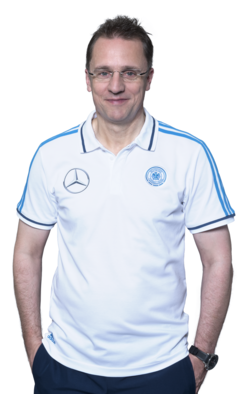For national soccer teams, players' health is key, particularly before and during major international tournaments like EURO 2016. Tim Meyer is one of the doctors responsible for the German national team and a professor of sports medicine at Saarland University. We asked him what goes into keeping a team of elite players in top medical shape and how he unites research and practice as he does so.
ResearchGate: What is the nature of your role with the German national team?
Tim Meyer: I am one of a team of doctors and manage all complaints except musculosceletal issues. This means I have responsibility for all aspects of internal and general medicine for the team. Due to my job as a university professor and my areas of research, I'm particularly called on for advice about load and recovery management, as well as recommendations regarding "innovations" coming from science. Finally, anti-doping matters also fall under my responsibility. So altogether this makes for a nice mixture. I am definitely not bored during tournaments like the EURO 2016!
RG: What have some of the biggest medical challenges been for EURO 2016?
Meyer: In contrast to the 2014 World Cup in Brazil, things like climate, hygiene, and jetlag aren't issues for EURO 2016. Therefore, managing fatigue, particularly in the players from the most successful clubs, has been the leading issue during preparation and the early stages of the tournament. Later--as in most championships--it is mainly about the daily management of complaints and training load.
RG: What kind of scientific research informs your work?
Meyer: The main source of information is research conducted with highly trained athletes, particularly football players. Together with Franco Impellizzeri, I have the honor of editing a regular supplement of the Journal of Sports Sciences called "Science and Medicine in Football." It covers areas of interest for medical doctors and sport scientists taking care of elite teams. At the Institute of Sports and Preventive Medicine, we host a PhD program for "Science and Health in Football" that also typically addresses interesting questions in this area.
Of course, other types of research--more basic ones or studies conducted in lower level players--can in principle still be relevant. However, their transferability to top-level players is often questionable. Therefore, investigations with professional football players are indispensable, despite the difficulties of carrying them out; there is limited accessibility to players, and coaches and players can be hesitant about participating. However, some countries like Australia and England have programs in place that are ideal for this kind of research. These teams have "embedded" scientists, who work partly for a university and partly for a professional club. I like this approach very much.
"Investigations with professional football players are indispensable, despite the difficulties in carrying them out."
RG: Are you able to apply your work with the national players to your own academic research?
Meyer: Mainly, my work with the team gives me research ideas and improves my ability to access high-level athletes. I hope that the students at Saarland University can benefit from this work as well. Working for the team means I'm often absent from the university, but I hope the practical experience these absences facilitate is helpful for my teaching and that of my co-workers.
RG: How much contact do you have with the doctors of other national teams? Are there opportunities for research collaboration?
Meyer: We meet at the matches, of course, and sometimes at international meetings and conferences. I know many of them well, and we maintain a very good collegiate relationship, despite the competitive nature of the national teams' matches. I could tell you several stories about practical help between team doctors. For example, a colleague from the Netherlands and I were able to cooperate to pressure a match commissioner to allow the placement of water bottles next to the pitch for a match in very hot weather. The commissioner hadn't wanted anything distracting from perimeter advertising. Also, the doctor of the home team often takes care of medical necessities (like quick hospital access) for the visiting team if any difficulties crop up. For the vast majority of my colleagues, medical responsibility by far overcomes rivalry. For this reason, meeting colleagues at the international tournaments is really an enjoyable event. However, research collaborations are rare and generally don't involve national team players.
"For the vast majority of my colleagues, medical responsibility by far overcomes rivalry."
RG: Do you have the impression that different teams' doctors have different scientific approaches?
Meyer: I would say rather that they have different practical and sometimes cultural approaches. Some utilize scientific input much less than others because of their individual educational backgrounds. Also, therapeutic approaches are quite different between continents, and sometimes even between countries. Because comparative studies of athletes at this level are lacking, one cannot easily decide which is the objectively best way to go. This is possibly also one of the reasons that traditions still have such importance, even in high-level football.
RG: What's it like working with the national team on a personal level?
Meyer: With the current generation of players, it's very easy. They have usually gone through high performance youth centers in their clubs and experienced structured care over a long period of time. Due to their extensive use of social media, they are also well-informed about matters of importance for their lives as professional football players. This enables good discussions on one hand, and makes them willing to accept convincing explanations on the other. That was a bit more difficult in the past.
RG: What future advances in sports medicine research would be particularly helpful to your work?
Meyer: I'd say a more realistic description of the scale of interventions' effects would be beneficial. Let's take cold water immersion, which is hyped in some instances to facilitate quick recovery. It definitely has potential, but will also not be effective for all players. Therefore, a more precise understanding of this variability would be a great advantage. We also need to be aware that with the growing number of "experts" around football teams, there is also a growing need for them to "advertise" themselves and explain that they are not superfluous. This seems to lead to an inflation of announcements about innovative breakthroughs in areas like nutrition and recovery-supporting tools.
RG: What's your overall impression of the state of medicine in elite football?
Meyer: There is no progress without trying something new, without scientific studies--not even in professional football. All stakeholders should be aware of that and cooperate with scientists who are willing to share their expertise with the football community.
This interview originally appeared on ResearchGate News.

